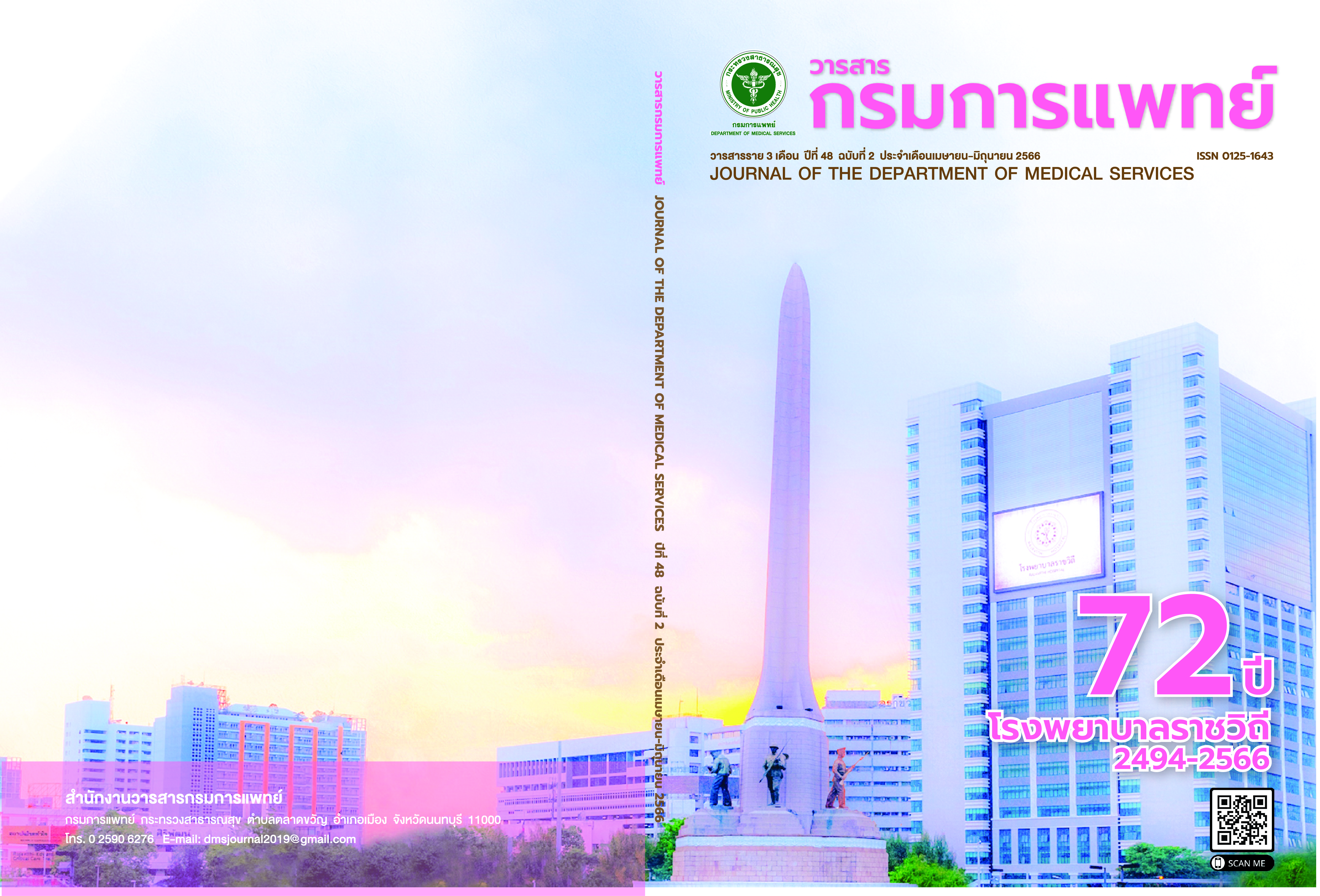Prevalence of Carbapenem Resistant Enterobacteriaceae and Carbapenemase Genes in Lerdsin Hospital
DOI:
https://doi.org/10.14456/jdms.2023.18Keywords:
Prevalence, Carbapenem resistant Enterobacteriaceae, CRE, Carbapenemase geneAbstract
Background: Carbapenem Resistant Enterobacteriaceae (CRE) is a global problem including in Thailand. Mostprevalence studies are conducted at the phenotype level because studies at the genotype level have many limitations, especially in terms of cost. Objective: This study aimed to determine the prevalence of CRE and carbapenemaseproducing genes to assess the situation of Lerdsin Hospital. Method: Routine reports from 2017 to 2021 were analyzedfor the prevalent study. 48 isolates of Klebsiella pneumoniae (K. pneumoniae) and Escherichia coli (E. coli) fromfour groups of specimens: blood, urine, sputum, and sterile site that showed carbapenem resistance by microbrothdilution, were tested for blaKPC, blaNDM, blaOXA-48, blaVIMand blaIMP by multiplex PCR technique. Result: The resultsshowed that carbapenem-resistant K. pneumoniae and carbapenem-resistant E. coli had a rising trend. In 2017, thenumber of cases of carbapenem-resistant K. pneumoniae was 31.42% and carbapenem-resistant E. coli was 1.39%.It then increased to 38.83% and 3.55%, respectively in 2021. The highest prevalence was found at the intensive careunit and mostly found in sputum and followed by urine, blood, and sterile site. Multiplex PCR for detecting five majorcarbapenemase-producing genes was identified from 48 samples, of which 31 isolates were K. pneumoniae and 17isolates were E. coli. There were 20 isolates (41.7%) found in target genes: 12 isolates from K. pneumoniae and 8isolates from E. coli, blaNDM and blaOXA-48 were found in 10 isolates equally. The blaNDM gene was most found in E. coli from the sterile site, and the blaOXA-48 gene was most found in K. pneumoniae from urine. Conclusion: This studyshows a rising trend of CRE in Lerdsin Hospital. This CRE problem is not only caused by carbapenemase-producinggenes but may also be caused by other mechanisms or a combination of several mechanisms.
References
Codjoe FS, Donkor ES. Carbapenem Resistance: A Review. MedSci (Basel) 2018;6(1):1-28.
O’Neill J. Review on Antimicrobial Resistance. Tackling drugresistant infections globally: final report and recommendations.May 2016. [cited 2019 Feb 22]. Available from: https://www.biomerieuxconnection.com/wp-content/uploads/2018/04/Tackling-Drug-Resistant-Infections-Globally_-Final-Reportand-Recommendations.pdf.
World Health Organization. Antimicrobial Resistance: GlobalReport on Surveillance 2014. [internet]. 2019 [cited 2019Feb 22]. Available from: https://apps.who.int/iris/ bitstream/handle/10665/112642/9789241564748_eng.pdf.
Centers for Disease Control. Antibiotic Resistance Threats inthe United States 2019. [internet]. 2019 [cited 2020 May 05].Available from: https://www.cdc.gov/ drugresistance/pdf/threats-report/2019-ar-threats-report-508.pdf.
National Antimicrobial Resistance Surveillance Thailand.Situation of antimicrobial resistance 2000 - 2020 [internet]. 2020[cited 2021 Sep 08]. Available from: http://narst. dmsc.moph.go.th/data/AMR%202000-2020-12M.pdf (in Thai)
Noitachang W, Prachayasittikul V, Lawung R. Situation Analysisof Carbapenem-Resistant Klebsiella pneumoniae in UttaraditHospital Between 2015 and 2017. Bamras j 2020;14(1):1-9.
Gupta N, Limbago BM, Patel JB, Kallen AJ. Carbapenem-resistantEnterobacteriaceae: epidemiology and prevention. Clin InfectDis 2011;53(1):60-7.
Taggar G, Attiq Rehman M, Boerlin P, Diarra MS. MolecularEpidemiology of Carbapenemases in Enterobacteriales fromHumans, Animals, Food and the Environment. Antibiotics 2020;9(10):693.
Yong D, Toleman MA, Giske CG, Cho HS, Sundman K, Lee K,et al. Characterization of a new metallo-beta-lactamase gene,bla(NDM-1), and a novel erythromycin esterase gene carriedon a unique genetic structure in Klebsiella pneumoniaesequence type 14 from India. Antimicrob Agents Chemother2009;53(12):5046-54.
Nordmann P, Naas T, Poirel L. Global spread ofCarbapenemase-producing Enterobacteriaceae. Emerg InfectDis 2011;17(10):1791-8.
Li Y, Li J, Hu T, Hu J, Song N, Zhang Y, et al. Five-year changeof prevalence and risk factors for infection and mortality ofcarbapenem-resistant Klebsiella pneumoniae bloodstreaminfection in a tertiary hospital in North China. Antimicrob ResistInfect Control 2020; 9(1):79.
Wu D, Cai J, Liu J. Risk factors for the acquisition of nosocomialinfection with carbapenem-resistant Klebsiella pneumoniae.South Med J 2011;104(2):106-10.
Peawpong C. Incidence of Carbapenem–resistantEnterobacteriaceae in Suratthani Hospital. Reg 11 Med J.2016; 30(2):1-12.
Arsheewa W. Prevalence of carbapnemase enzyme in clinicalisolates of carbapenem-resistant Enterobacteriaceae fromPrapokklao Hospital in 2012-2013. J Prapokklao Hosp Clin MedEducate Center 2016; 33(4):213-25.
Mukdapecharat T. Prevalence of Carbapenem-ResistantEnterobacteriaceae (CRE) And Control Measures to Prevent TheSpread of Infections in Patients across Trat Hospital. Departmentof Health Service Support Journal 2019; 15(3):51-61.
Ottiwet O. The prevalence of Carbapenem ResistantEnterobacteriaceae in Mukdahan Hospital. Department ofhealth Service Support Journal 2020; 16(2):47-56.
Sadsee P. Prevalence of Carbapenem ResistantEnterobacteriaceae at SomdejphrachoataksinmaharajHospital, Tak. Bamras. J 2019; 13(2):78-86.
National Antimicrobial Resistance Surveillance Thailand.Situation of antimicrobial resistance [internet]. 2019 [cited 2019Jul 27]. Available from: http://narst.dmsc.moph.go.th /data/AMR2560.pdf
Thongkoom P, Kanchanahareutai S, Chantrakooptungkul S,Rahule S, Pupan M, Tuntrakul P, et al. Carbapenem-ResistantEnterobacteriaceae at Rajavithi Hospital: Results of aMicrobiology Laboratory Program (2009-2015). J Med AssocThai 2017;100(2):212.
Cui X, Zhang H, Du H. Carbapenemases in Enterobacteriaceae:Detection and Antimicrobial Therapy. Front Microbiol 2019;10:1823.
David van Duin, Yohei Doi. The global epidemiology ofcarbapenemase-producing Enterobacteriaceae. Virulence 2017;8(4): 460-9.
Yungyuen T, Chatsuwan T, Plongla R, Kanthawong S,Yordpratum U, Voravuthikunchai SP, et al. NationwideSurveillance and Molecular Characterization of CriticallyDrug-Resistant Gram-Negative Bacteria: Results of the Research University Network Thailand Study. Antimicrob AgentsChemother 2021;65(9).
Noitachang W, Prachayasittikul V, Lawung R. Sutuation Analysisof Carbapenem-Resistant Klebsiella pneumoniae in UttaraditHospital Between 2015 and 2017. Bamras. J 2020;14(1):1-9.
Laolerd W, Akeda Y, Preeyanon L, Ratthawongjirakul P,Santanirand P. Carbapenemase-Producing Carbapenemresistant Enterobacteriaceae from Bangkok, Thailand, andtheir detection by the Carba NP and Modified carbapeneminactivation method tests. Microb Drug Resist 2018; 24(7):1006–11.
Downloads
Published
How to Cite
Issue
Section
License
Copyright (c) 2023 Department of Medical Services, Ministry of Public Health

This work is licensed under a Creative Commons Attribution-NonCommercial-NoDerivatives 4.0 International License.
บทความที่ได้รับการตีพิมพ์เป็นลิขสิทธิ์ของกรมการแพทย์ กระทรวงสาธารณสุข
ข้อความและข้อคิดเห็นต่างๆ เป็นของผู้เขียนบทความ ไม่ใช่ความเห็นของกองบรรณาธิการหรือของวารสารกรมการแพทย์



